Hundreds of Monarch butterflies paused in the Texas Hill Country this weekend as winds from the south and temperatures in the 90s prevented the migrating insects from continuing their journey south.
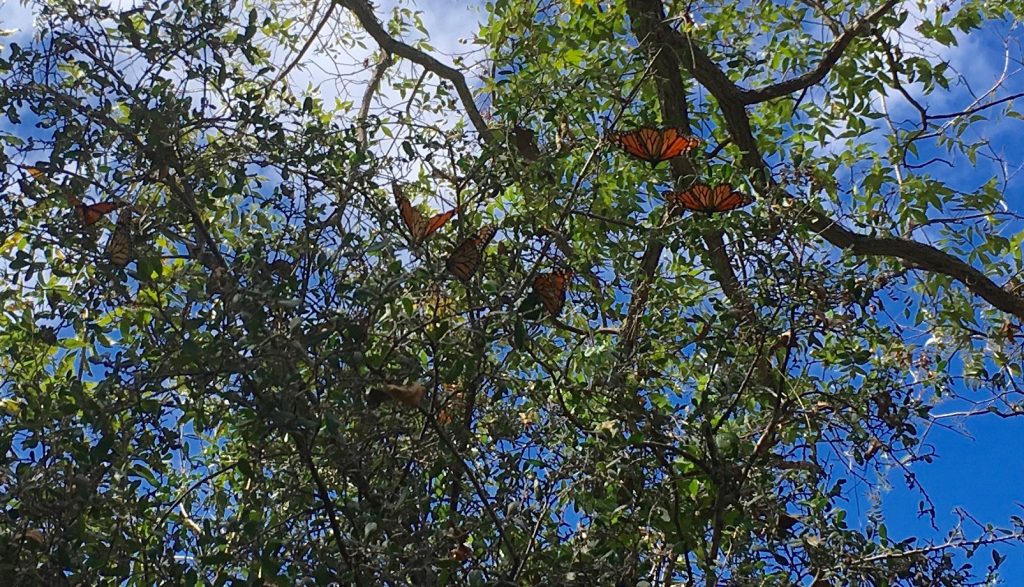
Small clusters of six-12 Monarch butterflies battled the wind and 90-degree temperatures along the Llano River this weekend. Photo by Monika Maeckle
Most late season nectar plants had passed their peak, with much of the Frostweed, Verbesina virginica, and Goldenrod, Solidago altissima, two late season nectar favorites, starting to go to seed. Cowpen daisies, Verbesina enceliodes, situated in shady spots produced lush, new blooms, offering the stymied flyers a fuel stop.
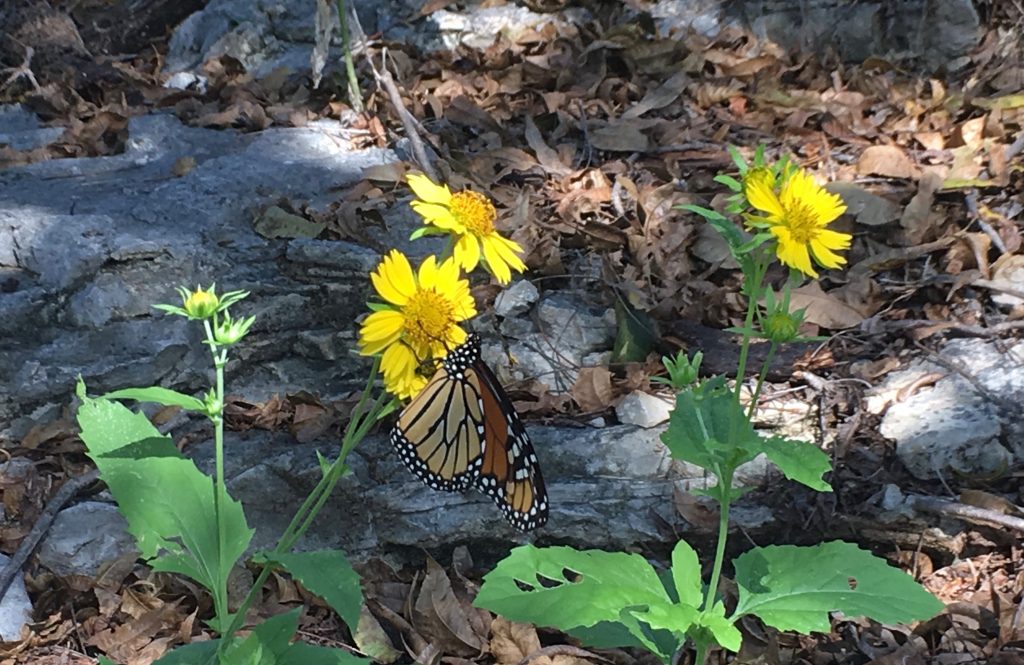
Patches of Cowpen Daisy offered fuel stops for migrating Monarch butterflies in the shade of Llano River pecan trees. Photo by Monika Maeckle
On the river banks, Swamp milkweed, Asclepius incarnata, host plant for Monarchs and Queens, showed fresh foliage for late season caterpillars, providing plenty of host plant for those Monarchs who chose to ditch the migration and reproduce locally.
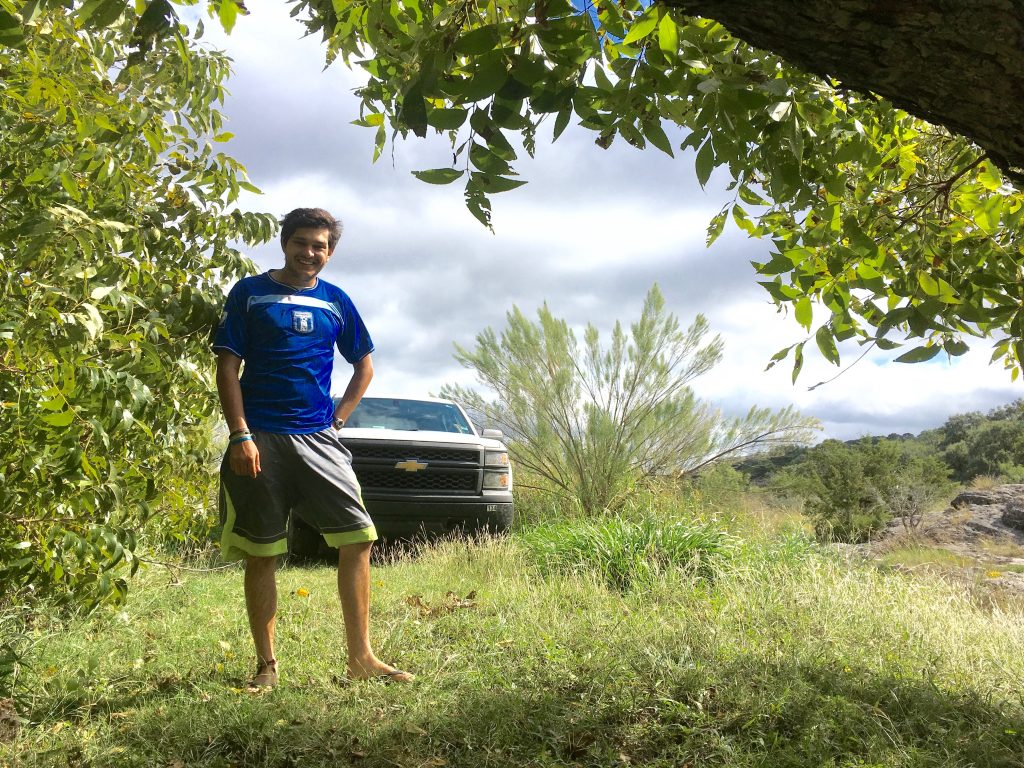
David Berman, PhD candidate at Oklahoma State University, is studying late generation Monarch butterflies and parasitoids. Photo by Monika Maeckle
David Berman, PhD candidate in the integrative biology program at Oklahoma State University, made the second of three scheduled visits to the ranch this weekend.
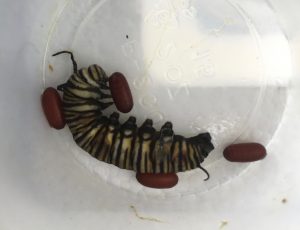
Eeew.Monarch caterpillar killed by the parasitoid Tachinid fly larvae. Those red “pills” are the pupae of the fly. Photo by Monika Maeckle
Berman is gathering data for a study funded by the Texas State Comptroller’s Office and other organizations, looking at the impacts of parasitoids and fifth generation Monarch butterflies on the migrating Monarch population.
In the back of his white Durango, Berman carried an entire ice chest filled with dead Monarch and Queen caterpillars collected in Texas and infected with Tachinid flies. The gross fly has a science fiction-like life cycle: it deposits its eggs on Monarchs and other caterpillars, which then hatch inside the caterpillar and eat it from the inside out.
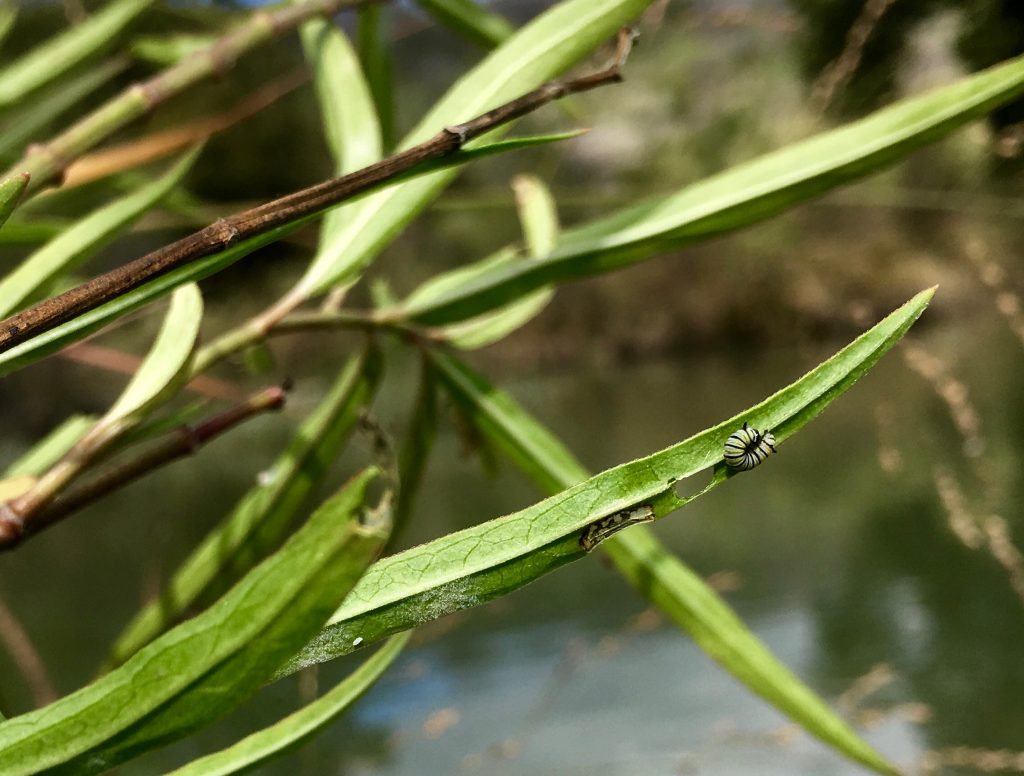
Second instar Monarch caterpillar on the Llano River, October 16, 2016. Photo by Monika Maeckle

Third instar Monarch caterpillar, Llano River, October 16, 2016. Photo by Monika Maeckle
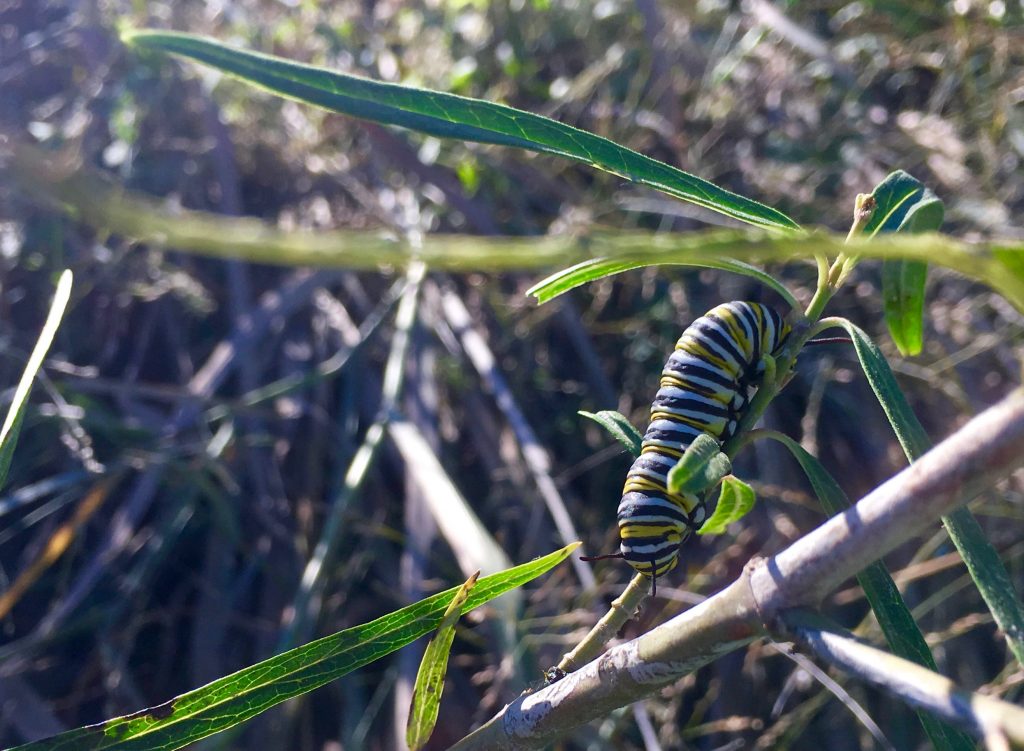
Ready to bust his stripes. Fifth instar Monarch caterpillar, October 16, 2016 on Llano River. Photo by Monika Maeckle
Here along the Llano, known as the “last wild river” in Texas, dozens of Monarch butterfly caterpillars in all stages of development —eggs, caterpillars and adult butterflies in migrating mode—supplied plenty of data for his study.
“I’d have to agree with Dr. Chip Taylor that the migration will be late and long this year,” said Berman.
A small tagging team attempted to net the smaller-than-usual clusters of six-10 butterflies we usually encounter during peak Monarch season.
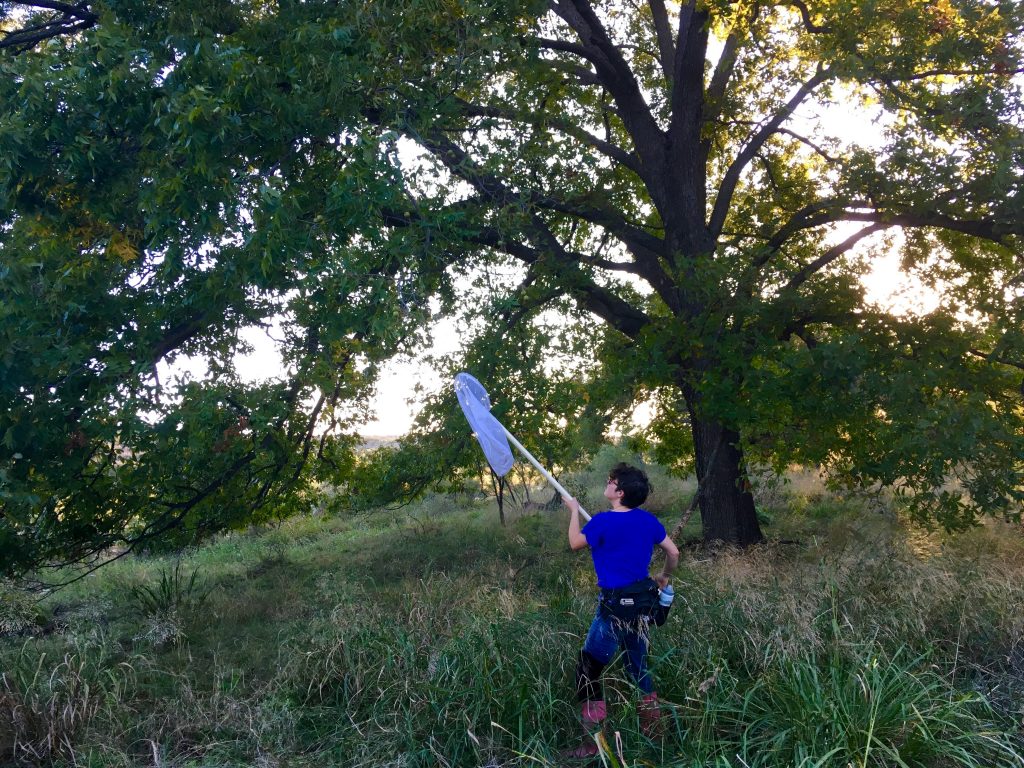
Victoria Echeverri of San Antonio takes her best shot at a cluster of Monarchs waiting out the wind on the Llano River. Photo by Monika Maeckle
High temperatures in the low nineties and winds out of the south gusting at 29 mph thwarted the butterflies directional flight south. They also seemed more skittish than usual, clinging to pecan limbs close to the limestone escarpment that provides a scenic backdrop to our river bottom.
Every time they left a pecan limb or cedar branch to continue their travels, a rush of wind would push them back. The wind made netting the creatures more challenging than usual, as the slightest pivot of the Monarch’s wings or body would allow them to take a dramatic turn and avert our swoops. A full day on the river only netted 58 tagged, compared to three times that many last year.
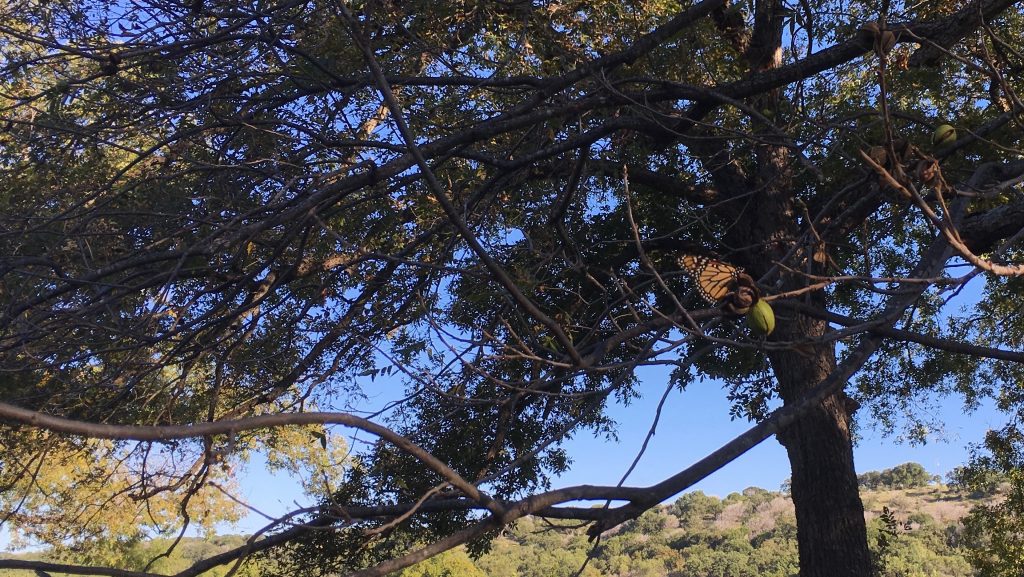
Pecan nuts made a convenient rest stop on the Llano River for migrating Monarch butterflies. Photo by Monika Maeckle
As the sun set on a mid October day that called for shorts and t-shirts instead of the usual jeans and long sleeves, we all wondered: is this the new normal? Rather than dramatic dense clusters of hundreds or thousands of butterflies roosting a few nights as in peak seasons past, maybe we’ll be seeing smaller groups over many weeks.
Related posts:
- Can’t get outside? Here’s how to track the Monarch migration from your desk
- Texas Comptroller awards $500K in Monarch research grants
- Butterfly bonanza: Monarch netted on Llano River tagged in Oklahoma
- How to Tag a Monarch Butterfly in Six Easy Steps
- What does climate change mean for Monarch butterflies?
- Snout-nosed butterfly invasion returns to South Texas
- New study: late season nectar plantsmore important than milkweed to Monarch migration
- Should You Bring in a Late Season Caterpillar into Your Home?
- How to Tell Queens from Monarchs
- How to Raise Monarch Butterflies at Home (First of Two Parts)
- Coming soon: Grupo Mexico copper mine in heart of Monarch butterfly roosting sites?
- Will the Monarch Migration Become Extinct?
Like what you’re reading? Follow butterfly and native plant news at the Texas Butterfly Ranch. Sign up for email delivery in the righthand navigation bar of this page, like us on Facebook, or follow us on Twitter, @monikam.

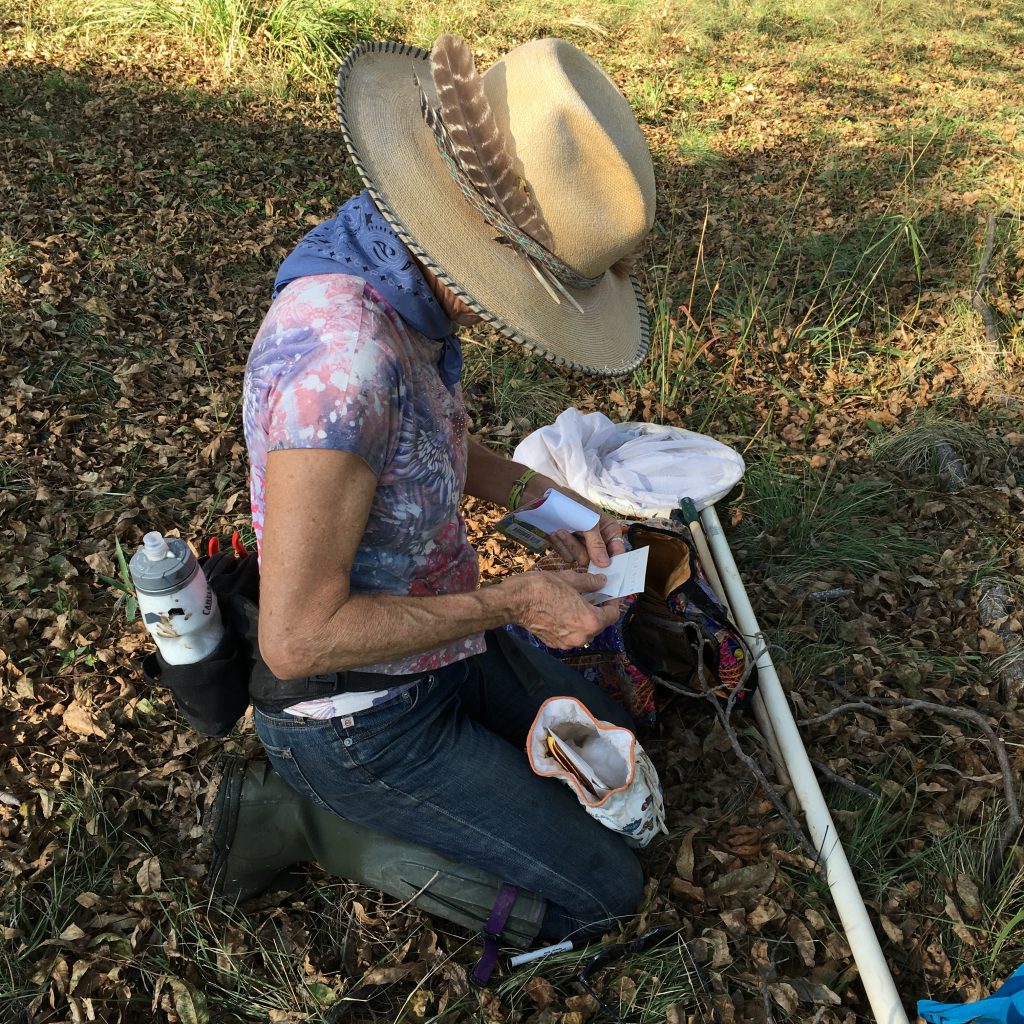
I’m feeling inspired! I actually had the pleasure to watch female Monarch butterflies laying eggs on the underside of the milkweed leaves in my backyard. Spotted a Caterpillar today!
I’m in Sugar Land, Texas.
We found a tagged Monarch and not sure where to report it as I did not want to injure it and I could not see all the writing very well but I did get the tag number
Can you tell me where to post it and how I can find out where it was released from … we plan to start tagging ours next season we birthed several hundreds this year
I would imagine that the tag is from Monarch Watch. I know that they hire people at the overwintering grounds to count and record tags. I’ve met with the Monarch Watch people, and I’m sure they would be very helpful in letting you know if you can report seeing a tagged monarch in your area and what the number was. Here is a link to their website is monarchwatchDOTorg.
For the first time in my life I want to go and see the beauty of it
Am from New Mexico desert and don’t know where to start ! Can I grave a guide of the places
I am anxious to see the results fro the Tachinid Fly research. I am in Thousand Oaks Calif, over the hill from organic farming. 80% of the caterpillars I put in my habitat 3rd instar or larger die from the fly.
We are trying to reach Monika for a speaking engagement about this topic. Can she or someone else contact me at xxx-xxx-xxxx? Thank you so much 🙂
Please contact us next week after Festival is over. Gracias.
Also curious to hear the results of the Tachinid Fly research.
I keep wondering if what the new normal may be as well. Thank you for sharing such a neat story of your peak season tagging day. The pictures are wonderful too. Your neighbor to the north~Bibi
I live on Shaw Island Road on Lake Buchanan in Bluffton, Texas, Llano County. The monarchs began arriving here in the middle of October, and they keep moving through my garden in large numbers. I have about 50 large milkweed plants, and they feast on them with great relish. They also like the lavender flowers on my vitex trees (aka Texas Lilac, Chaste Tree, etc.), bougainvilla, and other of the many blooming plants I have. Two things are different this year. (1) Their stay is much extended this year; (2) Above five or six other types of butterflies have joined the Monarchs. Truly, these butterflies surrounding me at this time are a great blessing in our currently discordant world.